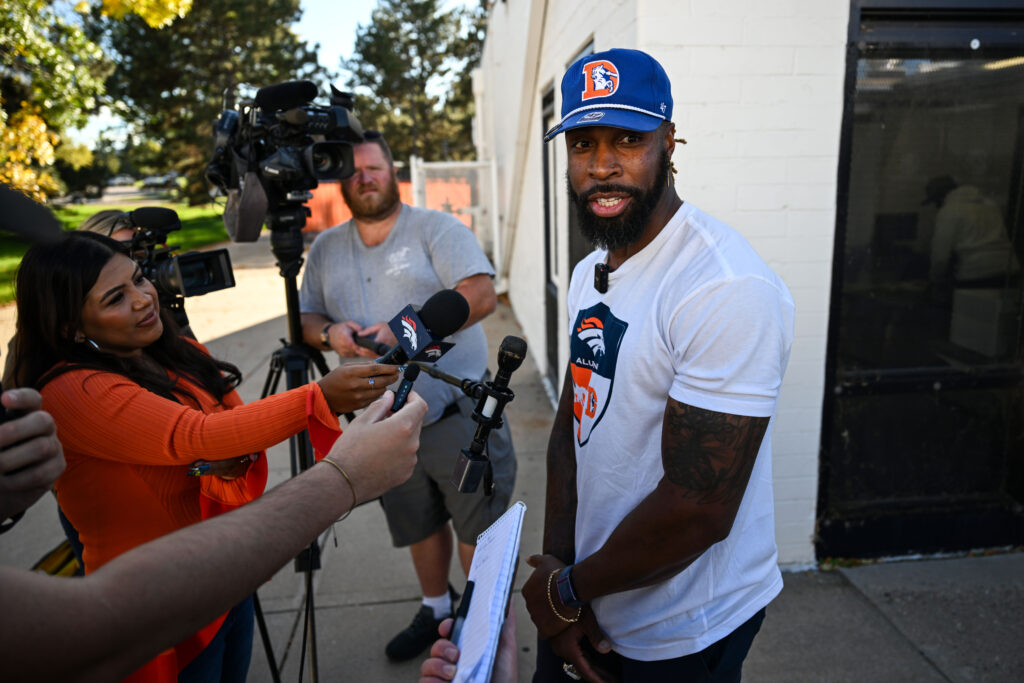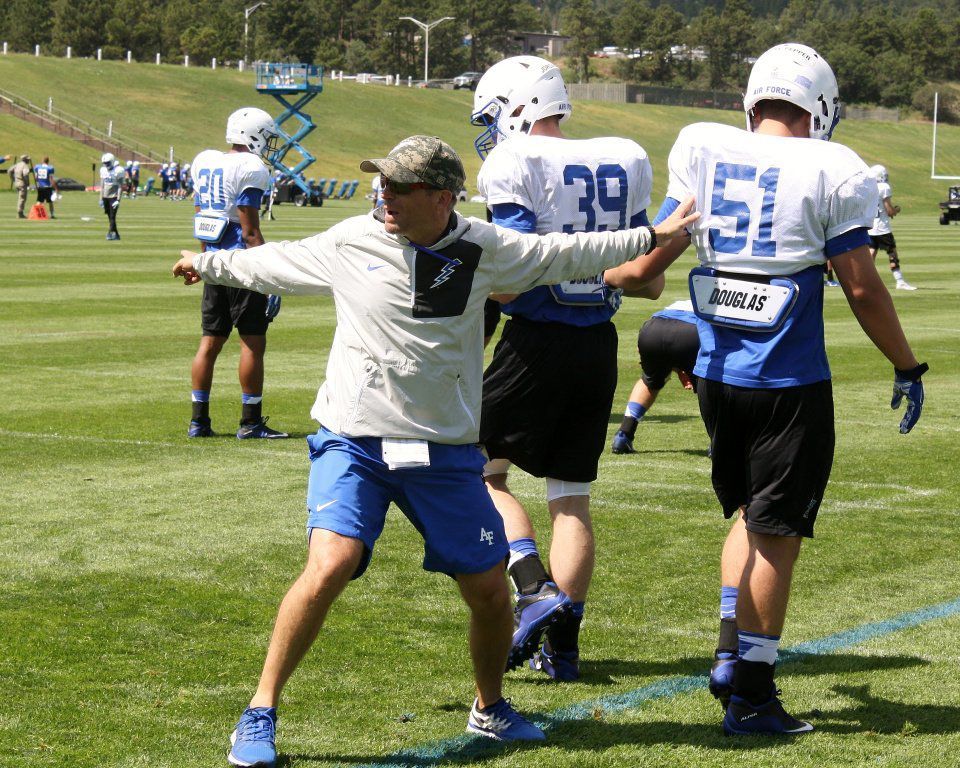Angela Rae Harris's Blog, page 5
October 14, 2025
Mark Kiszla: Can U.S. striker Haji Wright become the Ted Lasso story of the 2026 World Cup on American soil?
COMMERCE CITY – When Captain America went down with an ugly thud on the soccer pitch, his countrymen desperately needed a new hero to step up.
Can Haji Wright become the feel-good Ted Lasso story that the U.S. men’s team has been itching to tell?
With U.S. superstar Christian Pulisic nursing yet another injury, Wright scored both goals Tuesday night in Team USA’s 2-1 victory in a World Cup tuneup against Australia, slotted at No. 25 in last month’s FIFA world rankings.
“There’s always pressure,” Haji said. “Throughout the national team, there’s great players on the pitch. When I get my chance, I want to go out there and show what I can do.”
Haji is neither a new kid on the block nor an unfamiliar face to the USMNT. He scored against the Netherlands at the World Cup in 2022. But like this purported golden generation of American soccer, it’s starting to get late for Haji to seize his moment. At age 27, he had scored only five goals for Team USA in his career before suiting up against Australia.
With the clock ticking loudly toward next year’s World Cup, which opens in 239 short days on American soil, the U.S. team led by Mauricio Pochettino has been frantically searching for something, anything, to build a foundation of hope.
“The moment that we identified the problems,” Pochettino recently said, “we started to destroy the things that we need to destroy and started to build the house from the ground up.”
Any knucklehead can tear the whole thing down.
Since September 2024, when he was named coach of the U.S. team, Pochettino has often looked like a bewildered dude holding broken innards of a toilet in the plumbing aisle of your corner Ace store on a weekend morning, hoping a helpful hardware man will wander by and tell him how the pieces fit.
Little has come together for Pochettino in the past 13 months, and it probably won’t unless Pulisic, who has been battling a chronic ankle injury for what seems like forever and a day, gets 100 percent fit.
The good news: Pulisic was healthy enough to join the starting lineup against Australia.
The bad news? The Socceroos socked it to him repeatedly. They hammered Pulisic to the ground twice in the match’s opening 26 minutes, forcing him to the sideline.
“It was disappointing to see him leave with a hamstring injury,” said U.S. midfielder Cristian Roldan, who realizes how essential it is for a hale and hardy Pulisic “to get to the World Cup in a good spot.”
As Pulisic pulled on a puffy coat and walked slowly off the pitch, leaving behind teammates that were already facing an early 1-0 deficit, hope seemed to go with him.
But at almost the precise moment when the player so key to this country’s soccer aspirations that he’s called Captain America hit the locker room, a hero stepped out of the growing shadows for Team USA.
Wright, enjoying a breakout season with eight goals in nine games for second-division club Coventry City across the pond in jolly old England, is being given a look at striker.
And Wright struck a rocket shot that tied the match at 1-1 in the 33rd minute.
It infused a crowd of 18,218 red,white and blue fans so subdued they bordered on apathy to life, with chants of “U-S-A! U-S-A!” rocking the stadium.
“I am pleased,” said Pochettino, who griped about a thermometer dipping down to the 50s in Colorado’s thin air having an adverse effect on his players’ health. “But I wanted to see more.”
With renewed bounce in their boots, the U.S. men pushed the go-ahead goal past Aussie keeper Mathew Ryan only six minutes deep into the second half. Wright struck again, with a wicked crossover move that did Allen Iverson proud and broke the ankles of a defender before he slammed the ball in the lower left corner of the frame.
With the World Cup chasing the television money, the tournament field has been expanded to 48 teams, with 32 of the participants making the more-the-merrier knockout rounds.
On its home soil, will 2026 finally be the year the USMNT grows into a legit soccer power the world must finally take seriously?
What this team must gain in the eight months remaining to the World Cup is something Lasso likes to preach: belief.
“It’s not a coincidence,” Pochettino said, “to have this capacity to believe and really to say we trust in ourselves. That must be in our mind … in our heart, in our blood.”
Jamal Murray’s 30-point performance leads Denver Nuggets to 3-1 start to preseason | Vinny’s take
It’s just the preseason, but the Nuggets have their first win streak of the season.
Here are three takeaways from Denver’s third consecutive win, a 124-117 victory over the Bulls on Tuesday at Ball Arena.
1. Jamal Murray continued to look ready to change the narrative surrounding his slow starts to seasons. Murray scored 10 points in the first quarter, added 11 more in the second quarter and continued to attack into the third quarter. Murray finished with 30 points on 18 shots and a perfect 10-for-10 mark from the line, but his most impressive play of the night was a second-quarter bounce pass through traffic to Aaron Gordon for a dunk. Murray cut to the basket for a dunk on the Nuggets’ next possession. Denver’s No. 2 looks physically and mentally ready to start the preseason.
2. The rest of Denver’s starters looked ready to go, even if Cam Johnson’s still getting up to speed. Jokic and Gordon also ended the first half in double figures. Christian Braun impacted the game with some playmaking and defensive plays that led to easy offense. Johnson missed his first two attempts but got going with a couple of welcomed 3-pointers in the third. That group was largely responsible for an 18-0 run that broke the game open in the first quarter. All five of Denver’s starters were plus-15 or better in their minutes. Gordon had the best mark, winning the 22 minutes he was on the court by 32 points. Jokic added 18 points and was a couple of rebounds and assists shy of a triple-double in three quarters of action. Gordon scored 17, while Johnson added 11.
3. David Adelman continues to send a message with his rotations. For most the first half, Denver used a nine-man rotation, featuring Bruce Brown, Tim Hardaway Jr., Peyton Watson and Jonas Valanciunas in the second unit. When Adelman went to a 10th man, it wasn’t Jalen Pickett, Julian Strawther or DaRon Holmes II. It was two-way player Spencer Jones. Adelman has praised the defensive versatility Jones brings to the table and used him at center for a very short stretch of the second quarter. Strawther entered the game to start the fourth quarter, while Pickett and Holmes didn’t enter the game until the final five minutes with the rest of Denver’s third unit.
Democrats retreat in Vail raise intraparty eyebrows
A group of Democratic state legislators headed to Vail during the Oct. 4 weekend for an “opportunity caucus” retreat that also included lobbyists, raising a host of questions, including who paid for the getaway and whether the policymakers discussed the legislative business away from the public eye.
The “opportunity” caucus rejected the latter insinuation, saying the legislators met to discuss the business of the nonprofit entity and not legislation.
The progressive wing of the Democratic caucuses and its allies have criticized the retreat, which moderate legislators attended, in yet another tension point highlighting the division between the two wings of the party.
Sen. Lindsey Daugherty, D-Arvada — who, along with Rep. Shannon Bird, D-Westminster, leads the Opportunity Caucus — said the gathering was an avenue to talk about worries arising from recent polls showing people are leaving the Democratic Party in Colorado by the thousands.
“We are really worried about that,” Daugherty said, adding that people are also concern about being able to pay for housing or groceries, which has been a common focus at the state Capitol for the past several years.
She said the Opportunity Caucus wants to get back to the issues that the majority of people in Colorado want to address, as well as run proposals that work on the problems their constituents have raised.
“We’re focusing on accessibility, accountability and affordability,” Daugherty said. “We don’t believe we are moderate or progressive Dems, just a group of Dems focused on issues everyday Coloradans care about.”
They intend to be inclusive of all Democrats and the group’s goal was never to go after other party mates, she added.
The group is a 501(c)(4) nonprofit, which registered with the Secretary of State on Jan. 24. Other members of the Opportunity Caucus are Sens. Dylan Roberts of Frisco, Marc Snyder of Colorado Springs, Judy Amabile of Boulder, Kyle Mullica of Thoronton; and Reps. Cecelia Espenoza and Sean Camacho, both of Denver; Karen McCormick of Longmont; Meghan Lukens of Steamboat Springs; Rebekah Stewart of Lakewood; Jacque Phillips of Westminster; William Lindstedt of Broomfield; Michael Carter of Aurora; and Lesley Smith of Boulder.
The retreat’s site where roughly 15 Democrats stayed — the Sonnenalp Hotel in Vail — offers rooms for about $500 per night.
 With the combination of a slow shutter speed and racking of a zoom lens, the Senate chamber has the look of motion in the State Capitol on Wednesday, Jan. 24, 2024, in Denver. (AP Photo/David Zalubowski)
With the combination of a slow shutter speed and racking of a zoom lens, the Senate chamber has the look of motion in the State Capitol on Wednesday, Jan. 24, 2024, in Denver. (AP Photo/David Zalubowski)The group’s retreat appeared to anger progressive Democrats and their allies.
On X Monday, Deep Singh Badhesha, a Democratic lobbyist with ties to progressive legislators at the Capitol, suggested that Kent Thiry, who has bankrolled a series of ballot measures seeking significant election changes, was one of the funders.
The Opportunity Caucus is tied to One Main Street, which, from 2022 to 2024, raised more than $1.1 million to boost candidates for the state House and Senate with an eye toward business interests.
One Main Street’s independent expenditure committee (IEC) does not disclose its largest contributors, though funders of the group’s 501(c)(4) entity have included the Apartment Association of Metro Denver and the Associated Contractors of Colorado.
About $800,000 went to the IEC from One Main Street’s 501(c)(4).
One Main Street’s website shows eight moderate Democratic candidates it backed who won their primaries last year.
Daugherty said the retreat was paid for by the 501(c)(4) entity via membership dues paid for by the lawmakers.
A search of the campaign finance reports did not show any caucus dues paid to the 501(c)(4) with campaign funds from the members.
Lawmakers have listed caucus dues through TRACER.
In 2024, House Democratic lawmakers paid more than $52,000 in caucus dues, at about $2,500 per person, to several cash funds for House Democrats.
Senate Democrats paid just over $10,000 in caucus payments in 2024, with dues set at $750 per person.
No payments to the Opportunity Caucus showed up in those reports.
The Opportunity Caucus, the founders said in an op-ed, aims to “focus on the issues that truly matter to Colorado families — the kitchen-table concerns that affect paychecks, livelihoods and futures.”
“From housing affordability to high-quality jobs, better schools and strengthening our local economy, we are dedicated to pragmatic solutions that expand opportunity for all Coloradans. Together, we aim to foster a culture of leadership where problem-solving and consensus building create lasting progress for working families,” the group’s leaders said.
 FILE – The Colorado State Capitol is seen on Wednesday, Jan. 24, 2024, in Denver. The Democratic majority in Colorado’s House pushed forward two bills Friday, March 1, 2024 protecting transgender people’s chosen name. (AP Photo/David Zalubowski, File)
FILE – The Colorado State Capitol is seen on Wednesday, Jan. 24, 2024, in Denver. The Democratic majority in Colorado’s House pushed forward two bills Friday, March 1, 2024 protecting transgender people’s chosen name. (AP Photo/David Zalubowski, File)Among those who weighed in on the retreat was Rep. Meg Froelich of Englewood, who viewed it via progressive filters.
“Democrats should not cater to corporate interests, succumb to polluters’ calls for leniency, give into industry’s desire to rig the system or allow the wealthy to alter our electoral system in their favor,” she said on Bluesky, a social media platform like X.
The Working Families Party’s Wynn Howell, in a statement Friday, added: “This is what corporate corruption in our state legislature looks like: bringing legislators to an all-expenses-paid retreat at an upscale hotel in Vail, for ‘trainings’ with corporate lobbyists. These are exactly the kind of behind-closed-doors big money special interest politics that alienate voters and erode trust in our democracy.”
He also said it was “galling” to see lawmakers spending time mingling with corporate lobbyists at luxury retreats, instead of working to solve “real problems.”
In Colorado, the Working Families Party took in $1.5 million in 2024, mostly from unions. It spent about $336,000 in support of Democratic candidates for county commissioner, district attorney and largely progressive state lawmakers.
Some who attended the retreat told Colorado Politics that conversations focused primarily on issues, not on potential legislation.
Was it a public meeting?
That question hinges on a couple of factors, including a 2024 law that carved out the General Assembly from certain parts of the state’s open meetings law.
Daugherty said the caucus’ attorney, Scott Martinez, was present for the entire time in order to answer questions and ensure the members complied with the law.
Under Amendment 41, she said there are two exemptions to what are called “gift” prohibitions: One is answering questions as part of a program, which must educational, and the other is members are required to pay dues.
Jeff Roberts of the Colorado Freedom of Information Coalition outlined several factors contained in Senate Bill 24-157, the law carving out exemptions for legislators from the open meetings law.
The law changed the definition of “public business” for the General Assembly, Roberts explained.
What’s covered under the open meetings law are discussions of legislation, bills, resolutions or memorials already introduced; proposed legislation if in draft form, prepared by the legislature’s attorneys and discussed by a quorum or a statutory committee, interim committee or committee of reference, either during a regular or special session; or matters that are by nature interpersonal, administrative, personnel, planning processes or training.
So, where could the retreat fit as a matter of public business?
Daugherty said the purpose of the retreat was not to discuss public business — it was to discuss the business of the nonprofit.
There were educational panels during the retreat but nothing that would influence votes or open the members up to legal issues, she said.
Roberts cited Cole v. State, a 1983 ruling by the Colorado Supreme Court that held that legislative caucus meetings are meetings of policymaking bodies within the state’s open meetings laws and are therefore subject to the requirement that they must be open to the public at all times.
The Cole decision, however, did not get into a subsection of a party caucus, since the Opportunity Caucus — which has 15 members in the House and Senate — is just a portion of the total caucuses in both chambers.
There are 43 Democrats in the House and 23 in the Senate.
If something like this were to get litigated, Roberts said, it would be up to a judge to decide whether to look at the 2024 law or to the 1983 Supreme Court decision.
The 2024 law did not exclude caucus meetings from the open meetings law.
Roberts said the retreat is yet another example of lawmakers doing more outside the public eye, along with meetings by email or text or communicating via disappearing messaging apps.
Those can now happen without public notice or scrutiny.
Roberts said whoever paid for the retreat also matters since it can show who is trying to influence lawmakers.
Demaryius Thomas honored at Denver Broncos Boys and Girls Club: ‘It’s like a family reunion’
The spirit of Demaryius Thomas still lingers inside the Denver Broncos Boys and Girls Club.
“His energy was just explosive,” Malcinia “Nina” Conley told The Denver Gazette on Tuesday.
Conley, an education specialist, has worked in various roles at the Denver Broncos Boys and Girls Club since it opened in 2003. She recalls when Thomas first began visiting the club located in northeast Denver as a rookie in 2010. Thomas logged hundreds of volunteer hours over his nine seasons playing in Denver.
“Wherever he went, the excitement went,” Conley said. “He would get the kids hyped up. But he constantly stayed hyped up.”
 Bronco alumni Nick Ferguson, left, plays catch with Isaac Noclo, 8, during an ’88 Day’ alumni volunteer event at the Denver Broncos Boys & Girls Club in honor of late Broncos wide receiver Demaryius Thomas on Tuesday. (Stephen Swofford, The Denver Gazette)
Bronco alumni Nick Ferguson, left, plays catch with Isaac Noclo, 8, during an ’88 Day’ alumni volunteer event at the Denver Broncos Boys & Girls Club in honor of late Broncos wide receiver Demaryius Thomas on Tuesday. (Stephen Swofford, The Denver Gazette)In 2021, Thomas died as the result of seizure disorder complications. He was 33. On Tuesday, the Denver Broncos Boys and Girls Club honored his legacy with “88 Day” hosted by the team.
About a dozen Broncos’ alumni — including Steve Atwater (1989-98), David Bruton (2009-15), Nick Ferguson (2003-07) and Randy Gradishar (1974-83) — gathered for an afternoon of activities with the kids. They led flag football drills. They played soccer and basketball. Kids signed a giant banner with photos of Thomas at the Boys and Girls Club throughout the years.
“Seeing pictures of D.T. in there and knowing what this place meant to him. The time and energy that he spent here to help the kids, grow with the kids, and motivate them to be successful — it’s amazing that we’re out here and being able to commemorate D.T.,” Bruton said. “I think it was instilled in him at such a young age. … It was just who he was from his rookie year on (volunteering) here and going to other Boys and Girls Clubs.”
Bruton added that Thomas even volunteered while rehabbing from a torn Achilles.
“He would have been the first one here and the last one to leave,” Bruton said. “To make sure every kid got a chance to give him a high-five or show him a smile. Just have a conversation with him. That’s the type of guy he was. … I think his spirit is here. How we honor him is not just by being here but playing with the kids and interacting with them. Going out there and playing soccer or throwing the football with them.”
 Broncos alumni David Bruton talks with reporters during an ’88 Day’ alumni volunteer event at the Denver Broncos Boys & Girls Club in honor of late Broncos wide receiver Demaryius Thomas on Tuesday. (Stephen Swofford, The Denver Gazette)
Broncos alumni David Bruton talks with reporters during an ’88 Day’ alumni volunteer event at the Denver Broncos Boys & Girls Club in honor of late Broncos wide receiver Demaryius Thomas on Tuesday. (Stephen Swofford, The Denver Gazette)The Broncos are hosting an alumni weekend for their upcoming game Sunday against the Giants at Empower Field. It marks the 10-year reunion of their Super Bowl 50-winning team. Bruton was teammates with Thomas when they took home the Lombardi Trophy after the 2015 season.
Thomas finished his career as the Broncos’ second-leading receiver (9,055 yards) and third in catches (655). Bruton shared his favorite Thomas memories from behind the scenes.
“I remember when he would get a tattoo, and I’d give him a hard time,” Bruton recalled. “He had just got off injury, and he’d gained just a little weight, and I always gave him crap about it. But he always took it as good fun. … He was just a good, free spirit in the locker room. Went about his business and worked hard. But also worked hard in the community. That’s something you’ll always remember, right?
“His legacy was beyond what he did between the lines. His legacy was definitely what he did in the state of Colorado.”
 Broncos alumni Randy Gradishar leads a group of kids through exercise drills during an ’88 Day’ alumni volunteer event at the Denver Broncos Boys & Girls Club in honor of late Broncos wide receiver Demaryius Thomas on Tuesday. (Stephen Swofford, The Denver Gazette)
Broncos alumni Randy Gradishar leads a group of kids through exercise drills during an ’88 Day’ alumni volunteer event at the Denver Broncos Boys & Girls Club in honor of late Broncos wide receiver Demaryius Thomas on Tuesday. (Stephen Swofford, The Denver Gazette)Conley has vivid memories of Thomas wearing a Santa Claus suit during Christmas parties at the Boys and Girls Club. What motivated Thomas to pass out gifts to kids?
“Probably because of his experience when he was younger, and the things he went through. He knew the importance of giving,” Conley told The Denver Gazette. “To see the smile on a child’s face. To see the gratefulness and to see the happiness of that.”
Conley relishes it when the Broncos visit the Boys and Girls Club. Thomas is gone. But his memory still lives among the players who interact with their kids today.
“It’s like a family reunion,” Conley said.
 Kids run exercise drills with Broncos alumni during an ’88 Day’ alumni volunteer event at the Denver Broncos Boys & Girls Club in honor of late Broncos wide receiver Demaryius Thomas on Tuesday. (Stephen Swofford, The Denver Gazette)
Kids run exercise drills with Broncos alumni during an ’88 Day’ alumni volunteer event at the Denver Broncos Boys & Girls Club in honor of late Broncos wide receiver Demaryius Thomas on Tuesday. (Stephen Swofford, The Denver Gazette)
Air Force football makes change at defensive playcaller amid struggles
Air Force football made a change this past week at defensive playcaller, but coach Troy Calhoun painted the situation not as a demotion so much as a harkening back to his NFL experience.
Safeties coach Nick Toth called the defense this past week at UNLV, a decision Calhoun made after returning from the Navy game the week earlier. Calhoun said he asked defensive coordinator Brian Knorr to “look ahead” and begin preparation for Saturday’s game against Wyoming.
“We had Nick call the game last week, and we might do that moving forward, too,” Calhoun said Tuesday.
The Falcons lost 51-48 in Las Vegas on Saturday, continuing a trend of shootout losses during a five-game skid.
In revealing the move, Calhoun cited his time as an offensive assistant with the Denver Broncos. Some weeks head coach Mike Shanahan would call plays and for other games it would fall to offensive coordinator Gary Kubiak.
The same was true when Calhoun was the offensive coordinator with the Houston Texans. Kubiak, the head coach, served as the primary playcaller, but some weeks the role was entrusted to Calhoun.
“I just think it’s so good, man,” Calhoun said of sharing the responsibility. “It just makes everybody think big-picture a little bit better.”
Knorr remains listed as defensive coordinator and linebackers coach, while Toth – whose background includes four years as defensive coordinator at Fresno State as well as serving as Von Miller’s position coach at Texas A&M – remains listed as safeties coach.
 Air Force defensive assistant Nick Toth instructs during practice. (BRENT BRIGGEMAN, THE GAZETTE)
Air Force defensive assistant Nick Toth instructs during practice. (BRENT BRIGGEMAN, THE GAZETTE)“Is it a huge deal? Nah, I don’t know about that,” Calhoun said, “just because I think so much of your collaborative work (is done) during the week and your preparation.”
Though the move was downplayed by Calhoun, he couldn’t provide an example of having made a similar move in his previous 17 seasons at Air Force. And it comes during a season when the defense has been among the nation’s worst.
Out of 134 FBS teams, the Falcons are last in yards given up per game (496.7) and third from the bottom in points allowed (40 per game).
The offense has scored 30-plus points in all six games to open the season for the first time since 1998, but there is only a victory over FCS Bucknell to show for it.
Shifting playcalling responsibilities, at least at this point, does not necessarily mean different plays are available to the defense beyond the typical tweaks for situations and matchup for a new opponent.
“I guess it was a surprise, but I don’t think it was really a big effect for anyone on the team,” linebacker Dallas Daley said. “Like I said, it’s just the call coming in to the playcaller. We’ve still got to do our job.
“There’s been no change, really. No player on the team really looks into the hierarchy (of the defensive coaching staff), we’re just trying to play our game.”
Denver’s 5-year revenue outlook depends on 2026 budget
Denver’s financial outlook for the next five years relies heavily on its five-year revenue forecast.
And that forecast, in turn, depends on the final numbers approved in the city’s 2026 spending plan, which is expected on Nov. 10.
City budget officials said they first started seeing “a lot of anomalies” in revenue projections back in 2023 – anomalies that eventually would lead to the city revising its 2025 forecast and Mayor Mike Johnston scrambling to fill a $250 million hole in the city’s current and future budget.
They credit the use of the extended forecast in helping identify indicators, which, Johnston has said, played an essential part in curbing the number of layoffs and preventing the city’s budget woes from worsening.
City Budget Director Justin Sykes told members of the city’s Finance and Budget Committee on Tuesday that the purpose of the five-year revenue forecast is “not to set policy, but to serve as an objective tool for identifying trends and indicators that can help inform future city decisions.”
Nor does it lock in any future-year funding decisions.
There are several reasons the city prepares a five-year revenue forecast, Sykes said. First, it establishes a baseline projection of what to expect if current economic trends persist.
Second, it offers historical insight into the city’s revenue and expenditure patterns. Finally, it provides an early warning of any potential gaps in the future.
Focusing on the city’s top 35 revenue streams – which comprise approximately 95% of the general fund revenue – the forecast also offers context for policy decisions and future-year budget planning.
“The city prepares a new five-year forecast each year in early November, which is included in the final budget book,” said Laura Swartz, spokesperson for the city’s Department of Finance.
Denver is now on track to finalize its new spending plan next month, with budget experts projecting the city’s 2026 revenue to be $1.66 billion, slightly less than what the city forecast for 2025.
According to the Denver Department of Finance, projected revenue for 2026 is comprised of the following:
Sales and use tax: $928.4 million
Property tax: $195 million
Other sources: $540.9 million
The 2025 budget book provides a table of projected general fund revenues, with baseline, optimistic, and pessimistic revenue figures.
But those figures are no longer valid and must be recalculated.
Those numbers, while still available in the 2025 budget book, are now a year old, and Swartz said they “no longer reflect the actions taken in our current budget year – which have significantly reduced expenditures.”
“If you think back to a year ago, we were projecting that our general fund revenues would be higher, and so that was based on the best available information at the time when there were new tariffs declared, when the economic uncertainty that resulted from that kind of came to fruition,” Sykes said. “We revised down that projection for 2025, the current year, by $59 million, and so that is something that, as we’re getting new information, we are incorporating into those projections.”
When the 2026 budget is finalized, the five-year forecast will also be updated with new projections that go through 2030, incorporating figures from the 2026 adopted budget.
City officials have blamed flattening city revenues, driven — they said — by national economic uncertainty and rising costs, for much of Denver’s fiscal woes. They argued that, with early action to slow hiring in 2024, reduce the size of government in the 2025 budget and freeze hiring this year, the city managed to minimize the impact to employees and public services significantly.
Because of those early adjustments, the layoffs will only affect “171 employees, which represents 1.6% of the workforce,” city officials said in August.
Others cite Johnston’s spending on illegal immigrants and sheltering the homeless as factors contributing to the city’s deficit.
Johnston described his proposed 2026 spending plan as “cut to the bone,” calling the 5.8% reduction in spending the “most conservative” in 15 years.
“If there are any amendments to the budget that add cuts to any of the departments,” Johnston cautioned when he released his proposed budget in September, “those would directly either cut these core services or require more limits, because there is nothing left to cut in these departments…”
Swartz added, “The mayor’s 2026 budget will significantly reduce city spending and increase the city’s financial reserves – ensuring Denver is well-positioned to remain resilient if economic uncertainty continues beyond 2026. Identifying sustainable cost savings was an important and strategic focus for the city as part of the budgeting process this year.”
Feast your eyes on Jazz Holmes’ first solo exhibit ‘Nourishing’ at Denver Botanic Gardens
In early October, Jazz Holmes opened her very first solo art exhibition titled “Nourished” at Denver Botanic Gardens. Shortly thereafter, the artist traveled to Florida for the funeral of her grandmother, Lynda Jackson James.
“She was the matriarch of the family, so this show is definitely dedicated to her,” Holmes said in a walk-through of her vivid, mouth-watering-eye-candy artworks depicting people and plants affiliated with Creole cuisine.
 “Nourished,” the first solo show of artworks by Jazz Holmes, is on exhibit at Denver Botanic Gardens. (Courtesy photo, Scott Dressel-Martin/Denver Botanic Gardens)
“Nourished,” the first solo show of artworks by Jazz Holmes, is on exhibit at Denver Botanic Gardens. (Courtesy photo, Scott Dressel-Martin/Denver Botanic Gardens)One of the large-scale mixed media artworks depicts the artist pictured with her grandmother, mother and homegrown grapes.
“We were always called the three musketeers in the family. We were best friends, and she used to grow muscadine grapes in her backyard. I just wanted to celebrate my grandmother for passing down all of the recipes and all of her knowledge to my mom and to me. She got to see this before she left us. That’s all that matters to me,” said Holmes, who acknowledged the imprints her grandmother left upon her life and her art.
“She loved to knit and quilt,” said Holmes. “I had this whole box of silver beads that my grandma had found at a thrift store and given me. My grandma and all of her sisters always were covered rhinestones. I had those beads for about two years and never used them.”
Then, Holmes had a flash of inspiration while working on a large painting of her grandma holding a catfish.
 This painting honoring the artist’s grandmother holding a catfish caught from the Chattahoochee River and standing by a stone mill used to grind corn grits was the first artwork to which Jazz Holmes added rhinestones and beads, now a signature element of her art. (Courtesy photo, Scott Dressel-Martin/Denver Botanic Gardens)
This painting honoring the artist’s grandmother holding a catfish caught from the Chattahoochee River and standing by a stone mill used to grind corn grits was the first artwork to which Jazz Holmes added rhinestones and beads, now a signature element of her art. (Courtesy photo, Scott Dressel-Martin/Denver Botanic Gardens) She said: “It was just flat to me. And then I woke up and looked at it and I thought ‘that needs something to celebrate it.’ So I started drawing with the beads, is what I like to call it. And that became like a signature of mine.”
A transplant from the South to Colorado“My grandma had eight brothers and seven sisters, and they all had their own kind of farms, sharecropping land,” Holmes said. “Some of them lived in Louisiana, some of them lived in Georgia, some of them lived in North Carolina, and I moved around like a lot, so I just say I’m from the South.”
Holmes came to Colorado eight years ago to earn her Masters degree at Colorado State University.
“I chose Colorado because of nature,” the artist said. “I love nature, and I love agriculture, and the ranching culture here is different from the South.”
Holmes’ show lists the plant ingredients in the Creole dishes depicted in her art. Even her given name, Jasmine, is a plant, and she took an early interest in the Plant Kingdom.
‘I’ve always been that drawing kid’Holmes also leaned into art at an early age.
“I’ve always been that drawing kid. It’s always been in my blood to create something whether that’s drawing, painting, whatever I can get my hands on,” she said. “I grew up with two really nerdy video game designer parents. My mother was an illustrator, and my dad worked for Marvel. I learned to draw the human figure from my parents, and I grew up drawing a lot of video games anime and cartoons.”
Her parents also exposed Holmes to the natural world.
“Every summer they would uproot me and put me in this agricultural deep south area where I had nothing, so I was always drawing everything that was around me. I was studying the plants and the agriculture whenever I would go away for the summer so that influenced what I liked to draw.”
Her interest and application paid off. In 2020, DBG selected Holmes as one of the first Landline artists in residence.
“Holmes’ work tells a story about the many ways food nourishes us, not only providing our bodies with nutrients, but also connecting us to our families and ancestors through shared recipes and collective history,” said Moira Casey, DBG assistant curator of exhibitions. “Food is a universal basic human need, but the unique ways humans have cultivated and cooked different plants across cultures and time is what makes this story so powerful.”
Immigrants introduced ingredientsWhile Southerners often use their garden-grown ingredients, Holmes emphasized that immigrants introduced many key ingredients into Creole cuisine, a mix of French, Spanish, Italian, African, and Native American heritage.
 Jazz Holmes created a multimedia installation highlighting bananas and the slave labor associated with the fruit. (Courtesy photo, Scott Dressel-Martin/Denver Botanic Gardens)
Jazz Holmes created a multimedia installation highlighting bananas and the slave labor associated with the fruit. (Courtesy photo, Scott Dressel-Martin/Denver Botanic Gardens)“Tomatoes weren’t really used until a lot of Italian immigrants traded them. It’s always a mixture depending on who’s around, and that’s what makes it amazing, like the melting pot of the South,” Holmes said.
“Creole food is seen as elevated. I focus so much on Southern culture, because people see it as lower than, so I want to bring it into a space like this and celebrate it and make it look maximalist,” Holmes said. “And I’m the same way when it comes to Southern food, because there aren’t a lot of Michelin star Southern restaurants, even though everyone loves to eat Southern food.”
An especially eye-catching self-portrait depict two versions of artist — one embracing a giant crawfish, the other a giant shrimp. The painting is a nod, Holmes said, to the family’s hotly contested etouffee cook-off which, for the record, the artist recently won. The painting’s hot reds and oranges appear mouth-wateringly spicey.
“I’m connected to West Africa, and I was looking at how food was brought over from West Africa to here, and how we never gave up certain ingredients, like okra. It’s not native to America. We brought okra over so that we wouldn’t lose our connection,” said Holmes. “The use of peanuts and other ingredients made me realize the resilience and the celebratory nature of my culture rather than all pain. So, that’s one reason why the rhinestones and why there’s so much color.”
Holmes paints many colors of a Black personIn Holmes’ self-portraits and paintings of her Creole family, skin tones include vibrant blues, reds, greens and violets. The bold and bright palette calls to mind the expressive works by Thomas Evans, also known as I Am Detour, another Denver-based artist using vivid hues in faces of color. As it turns out, the two artists are friends and work in the same studio space.
“Jasmine’s work is amazing and soulful,” Evans said. “One aspect about her work that I really love is the natural fusion of beads and other items that she incorporates into the composition. It feels seamless and subtle while still adding a dynamic look and feel to the portraits that she paints. I love her approach to including the culinary arts into the conversation. It’s an especially unique fusion of expression. I’m always excited to see her works as she seems to be always creating.”
Food bridges language barriersHolmes drew comparisons between the visual arts and the culinary arts.
“I think of ingredients as my materials,” she said. “In my process, the way that I cook, I’m experimenting just like I do when it comes to art — thinking of texture, thinking of color, thinking of presentation. Taste is a vehicle for experience, so I think art and cooking overlap a lot and they should be put together a lot more.”
Holmes’ exhibit reminds visitors of the ways food brings people together across generations, across cultures and locations.
“Food is a type of language, just like music. With music, you don’t need to speak to someone else. You can just speak through the sound you’re making, and a lot of cultures can come together around music. Food is the same way.”
The bitterness of Bananas Foster“Nourished” includes Holmes’ multimedia depiction of a popular Southern dessert: Bananas Foster. But along with the sweetness the artist included a salty, sour, bitter taste, too. Beneath her beaded and collaged painting, Holmes installed a sculptural bunch of rhinestone bedazzled bananas rotating as if on a lazy Susan. The bananas are not yellow, but red.
“Blood red,” said Holmes, “because in some places, people are not paid to pick bananas. It’s still slave labor.” She noted a list of other crops involving less than equitable labor practices.
Holmes said: “We need to be mindful of all the food we eat.”
Visitors can feast their eyes on “Nourished,” through March 22, 2026. Holmes will present an artist’s talk in the Ladd Family Gallery, Sunday, December 7, noon to 1 p.m. The talk is free with admission and registration. More information: http://jazzholmes.com and The Denver Botanic Gardens website.
 Jazz Holmes hails from the South, but came to Colorado to complete her Masters degree and now calls Aurora home. (Colleen Smith/Special to The Denver Gazette)
Jazz Holmes hails from the South, but came to Colorado to complete her Masters degree and now calls Aurora home. (Colleen Smith/Special to The Denver Gazette)
Lakewood City Council approves zoning map
Lakewood finalized the last ordinance for its nearly 400-page zoning code proposal on Monday and approved the zoning map, ending a heated process that had sparked controversy in the city since the beginning of the year.
The final ordinance of the new Lakewood zoning code was approved with an 8-3 vote during the City Council meeting Monday.
The vote involving the zoning map came around midnight after countless public comments for and against the changes that have been stretched out over four separate council meetings over the last few months.
Councilmembers David Rein, Jacob LaBure and Paula Nystrom were the three “no” votes.
The zoning code, as a whole, has been highly debated since August, with some residents claiming that changes to single-family zoning would cause parking issues and change the characteristics of existing neighborhoods.
The update is the first major zoning code change since 2012 and will go into effect next year.
On Sept. 22, the council approved an amended version of Article 3 of the city’s 2026 zoning code proposal — the highly touted article that erases the term “single-family zoning,” which does not appear in the document. Instead, the city will use the term “residential dwellings.” A residential dwelling could be a single-family home, duplex, tri-plex or townhome in an effort to create more affordable housing.
The new residential districts are broken up into low-form residential and mid-form residential classifications.
Low-form residential will include single-family homes and small-scale attached and detached housing to “support compact, walkable neighborhoods with a range of housing options,” according to the proposal.
Mid-form will include medium-density housing and multi-family buildings.
Lakewood has never had single-family-only zoning, with all areas allowing some type of different usage like group homes or duplexes.
Those areas were approved on the map Monday, but some residents are still upset with the idea of duplexes and townhomes moving into neighborhoods and changing the areas’ character.
“We have 40-plus underutilized properties in this city. We have underdeveloped land in this city. We do not need to go into all of these neighborhoods and change the character, which is against the comprehensive plan, and decimate the environment,” Councilmember Nystrom said.
Furthermore, some public speakers were upset with a lack of information, claiming that the city had moved the discussion quickly along behind closed doors. They also want to be able to vote on the zoning proposal during the Nov. 4 election.
“You guys say it’s all about transparency? I don’t think so. You need to put this on pause so more people can find out about it,” resident Cheryl Ramirez said, adding that she’s getting a petition together to get the zoning changes on the November ballot.
The city has released multiple articles and information about the zoning changes on its website, and the councilmembers voted in August to stretch the proposal votes across four separate meetings to make sure public comments were heard.
The idea was to inform residents and allow ample time for public comment while still getting the votes across the line before the election. Some meetings stretched eight hours into the early morning.
“Of the people, by the people, for the people doesn’t mean you vote on every single thing. It means you vote on your representatives, who then can represent you,” Councilmember Glenda Sinks said. “I don’t believe that if we extended the vote that all 150,000 people in Lakewood would be informed about this zoning code. No matter how late we delay this, not everybody is going to know.”
But now the entire zoning code has been approved.
Despite some heated discussions and incoming petitions, other residents are happy with the changes, claiming the allowance for more middle-level housing will make for more affordable homes in the city.
“These changes are about the future, and that future needs to be inclusive and accessible to more than just the wealthy and mostly white population,” resident Ben Hensley said Monday. “That future needs to recognize that farming and horse rearing is not the future of this city. Farming and horse rearing in a city that’s so full of homelessness and poverty is a moral failure, anyway.”
“Lakewood is becoming more urbanized, and will continue to be a popular place for people to want to call home given the nice parks at Belmar Park and Green Mountain, as well as its location near Denver in the foothills of the Rockies. Buying a house is already unattainable for most people and renting is very difficult as well,” David Brown said on the city’s website. “Pass the zoning changes and keep Lakewood livable.”
A copy of the new zoning map can be found at LakewoodTogether.org.
Colorado extends tax deadlines for entities affected by floods
Colorado’s revenue department is extending state income and sales tax filing deadlines for people and businesses affected by the recent flooding in the southwestern part of the state.
Over the weekend, Gov. Jared Polis issued a disaster declaration for the floods, which were brought on by heavy rainfall due to tropical storm Priscilla, in La Plata and Archuleta counties. In Pagosa Springs, floodwaters in the San Juan River reached a 55-year high on Tuesday at nearly 13 feet.
In response to the disaster declaration, the Department of Revenue has extended the deadline for income tax extensions and sales tax filings to Dec. 31.
Taxpayers affected by the floods can request penalty waivers for other taxes and fees, including marijuana, fuel, and retailer delivery fees, throughout the month of October by contacting the revenue department.
The agency said it will not automatically apply the deadline waiver. Taxpayers are required to request to extend a deadline upon receiving their bill.
To request a waiver, taxpayer can call the agency at at 303-238-7378.
October 13, 2025
Denver area events for Oct. 14
If you have an event taking place in the Denver area, email information to carlotta.olson@gazette.com at least two weeks in advance. All events are listed in the calendar on space availability.
Tuesday
End It, Clique, End of Dayz, No Right & Polish — 6 p.m., Hi-Dive, 7 S. Broadway, Denver, $31.42. Tickets: hi-dive.com/events.
John McKay, Folk — 6 p.m., Rosetta Hall, 1109 Walnut St., Boulder; rosettahall.com.
Sipping N’ Painting Hampden — “Golden Aspens,” 6:30-8:30 p.m., Sipping N’ Painting Hampden, 6461 E. Hampden Ave., Denver, $35. Registration required: sippingnpaintinghampden.com.
Jeremy Zucker — With Bebe Stockwell, 7 p.m., Ogden Theatre, 935 E. Colfax Ave., Denver, $41.95-$100.37 Tickets: axs.com.
Denver Jazz Orchestra — 7 p.m., Dazzle at Baur’s, 1080 14th St., Denver, go online for prices. Tickets: dazzledenver.com/#/events.
Lorde — With Blood Orange & the Japanese House, 7 p.m., Red Rocks Amphitheatre, 18300 W. Alameda Parkway, Morrison, $313 and up. Tickets: axs.com.
Open Mic Night — Sign-ups start at 7 p.m. with performances at 8 p.m., Goosetown Tavern, 3242 E. Colfax Ave., Denver; goosetowntavern.com.
Indigenous Peoples’ Day Performance — 7:30-9:30 p.m., Newman Center for the Arts, Gates Concert Hall, 2344 E. Iliff Ave., Denver: newmancenterpresents.com.
Flyte — 8 p.m., Ophelia’s Electric Soapbox, 1215 20th St., Denver, $29.27. Tickets: opheliasdenver.com.
Will Paquin — With Otto Benson & Yan Yez, 8 p.m., Larimer Lounge, 2721 Larimer St., Denver, $24.60-$27.60. Tickets: larimerlounge.com.
Treasvre — With Cruel Morning & Sucio, 8 p.m., HQ, 60 S. Broadway, Denver, $16.38 and up. Tickets: hqdenver.com.
Stereolab — With Dorothea Paas, 8 p.m., Gothic Theatre, 3263 S. Broadway, Englewood, $54.02. Tickets: axs.com.
The Nightmare Bar — A 90-minute immersive Halloween experience with eerie cocktails, themed bites, spine-chilling decor and live entertainment inspired by your favorite scary movies, through Nov. 2, 5-10 p.m. weekdays, 3-10 p.m. weekends, The Church Nightclub, 1160 Lincoln St., Denver. Reservations: tinyurl.com/2x88vac9.
CARLOTTA OLSON, The Denver Gazette



